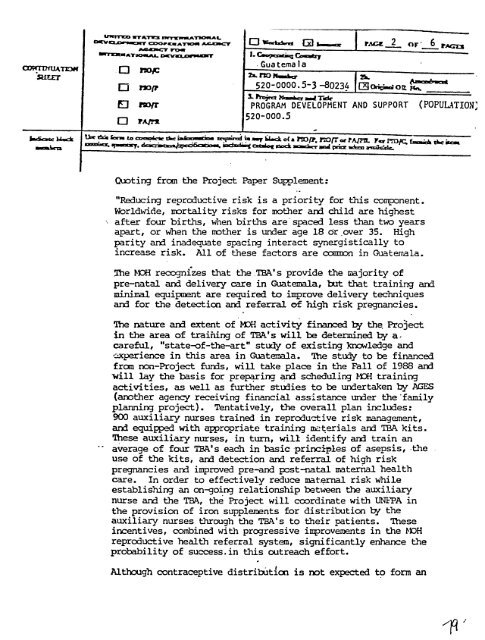0 - PDF, 101 mb - usaid
0 - PDF, 101 mb - usaid
0 - PDF, 101 mb - usaid
You also want an ePaper? Increase the reach of your titles
YUMPU automatically turns print PDFs into web optimized ePapers that Google loves.
00" 1Eh-UATIW<br />
04"1cA-- wr=a-r=^wm ^AC 0XIT E6- VMEr- -I-. OF 6<br />
AA43c r0._ _ _ __ _ _ _<br />
Guatemala<br />
0 nol? 520-0000.5-3 -80234 IN0o,;6_<br />
0 raw PROGRAM DEVELOPMENT AND SUPPORT (POPULATION'<br />
520-000.5<br />
0 P',. 2<br />
Quoting from the Project Paper Supplement:<br />
"Reducing reproductive risk is a priority for this component.<br />
Worldwide, mortality risks for mother and child are highest<br />
after four births, when births are spaced less than two years<br />
apart, or when the mother is under age 18 or over 35. High<br />
parity and inadequate spacing interact synergistically to<br />
increase risk. All of these factors are common in Guatemala.<br />
The MO recognizes that the .TBA's provide the majority of<br />
pre-natal arid delivery care in Guatemala, but that training and<br />
minimal equipment are required to improve delivery techniques<br />
and for the detection and referral of high risk pregnancies.<br />
The nature and extent of MOH activity financed by the. Project<br />
in the area of training of TBA's will be determined by acareful,<br />
"state-of-the-art" study of existing knowledge and<br />
,aperience in this area in Guatemala. The study to be financed<br />
from non-Project funds, will take place in the Fall of 1988 and<br />
will lay the basis for preparing and scheduling MOH training<br />
activities, as well as further studies to be undertaken by AGES<br />
(another agency receiving financial assistance under the family<br />
planning project). Tentatively, the overall plan includes:<br />
900 auxiliary nurses trained in reproductive risk management,<br />
and equipped with appropriate training materials and TBA kits.<br />
These auxiliary nurses, in turn, will identify and train an<br />
average of four TBA's each in basic principles of asepsis, the<br />
use of the kits, and detection and referral of high risk<br />
pregnancies and improved pre-and post-natal maternal health<br />
care. In order to effectively reduce maternal risk while<br />
establishing an on-going relationship between the auxiliary<br />
nurse ard the TBA, the Project will coordinate with UNEIPA in<br />
the provision of iron supplements for distribution by the<br />
auxiliary nurses through the TBA's to their patients. These<br />
incentives, co<strong>mb</strong>ined with progressive improvements in the MO0H<br />
reproductive health referral system, significantly enhance the<br />
probability of success.in this outreach effort.<br />
Although contraceptive distribution is not expected to form an

















